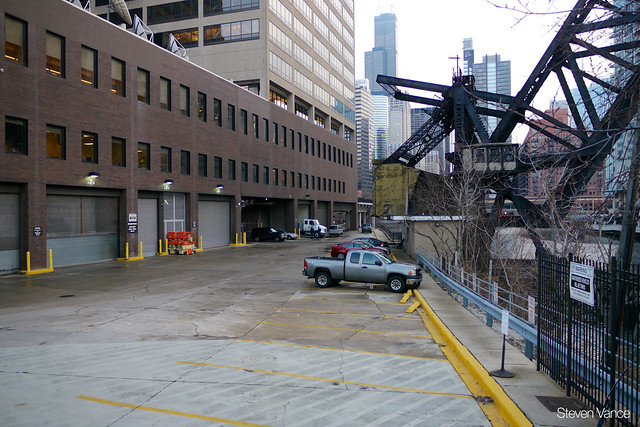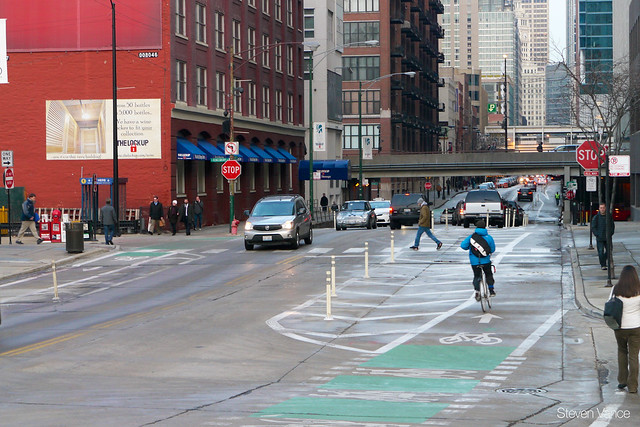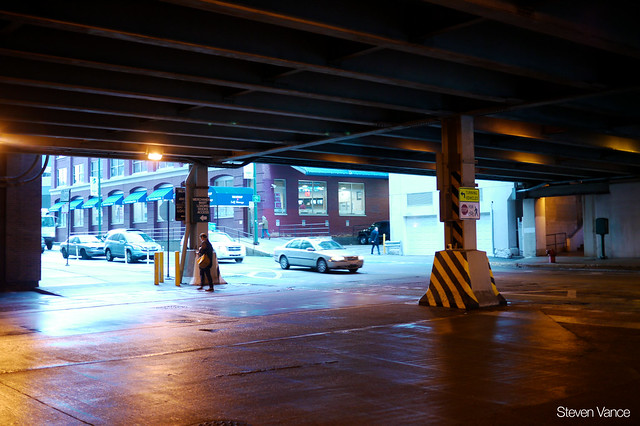The Wolf Point site, just south of the Apparel Mart and Chicago Sun-Times building at the confluence of the Chicago River's three branches, has been begging for more productive uses for decades. Momentum has been building since developers associated with the Kennedy family proposed a plan for three towers at Wolf Point in 2007, and the proposal picked up speed in 2012 as it began accumulating the various permissions needed to move forward. Last Thursday, all 21 members of the Chicago Plan Commission signed off on the project, at a hearing that revealed one of the key flaws in the way Chicago manages growth and development.
The Wolf Point development, with its 1,285 parking spaces, is expected to generate so many vehicle trips that the Chicago Department of Transportation will adjust nearby traffic signals to give more time to car traffic and less to pedestrians. Rather than guide this project in a way that makes the city more walkable and transit-accessible, the city is letting new development degrade the pedestrian environment.
The developers of the $1 billion Wolf Point project propose to build it in three phases. The first, which was approved by the CPC at the meeting, is a 510-unit apartment building with 200 parking spaces (see site plan). The second and third phases include two office towers with an additional 1085 parking spaces (485 of these are considered replacements of existing parking spaces; the zoning code requires zero new spaces and no replacements). As part of this first phase, the developers will pay for a wish list of transportation-related changes requested by CDOT, but the changes to local streets are intended mainly to accommodate a projected increase in car traffic, not make walking, biking, or transit a more attractive option for getting to Wolf Point.
View Wolf Point transportation impacts in a larger map
Among CDOT's requests are several new traffic signals, which will be paid for by the developer, including five turn arrows that will make walking less convenient. At the intersection of Kinzie and Kingsbury, for instance, a new traffic light will replace a three-way stop, meaning pedestrians have to wait longer to cross the street.
Traffic engineer Luay Aboona of project consultant KLOA told the CPC that the Kinzie/Kinsgbury signal would improve pedestrian safety, yet Illinois Department of Transportation crash data shows only two pedestrian injuries at this location from 2005 to 2011; the point of the signal is only to reduce delays for motorists. It may not seem like a big change, but this is the type of incremental degradation that Jane Jacobs referred to when she wrote that "the erosion of cities by automobiles... proceeds as a kind of nibbling."
Meanwhile, opportunities to improve the pedestrian realm are not getting attention. The Kinzie/Lower Orleans intersection is the entrance to an underground service drive for the towers and is particularly uncomfortable for pedestrians: It's dark, provides a sidewalk on the north side only, and lacks a crosswalk for pedestrians on the south side to cross to the north side. This intersection is not slated to receive any changes as part of the project.
The changes on CDOT's wish list for Wolf Point mainly reinforce driving as the easy choice for getting to and through downtown. Where are the changes to make it easier to walk and bike through here?
The developer's payment to the city will speed a few improvements that are already in the works, including the city's in-progress program to upgrade traffic signals to include countdown timers for pedestrians, and the conversion of crosswalks to the international style, with "ladder" stripes instead of just two parallel lines.
A more substantial change is the addition of a bike lane to Grand Avenue prior to construction. But this too was already planned, as part of the Streets for Cycling Plan 2020. In fact, the Grand Avenue lane will initially serve not as an addition to the bike network but as a substitute for the Kinzie lane, which will be partially out of commission during Wolf Point construction. It's not clear whether the Kinzie bike lane will be restored after construction wraps up. "However, it's too early to definitively say what the post-construction configuration of Kinzie will be several years from now, based on the level of usage and success of the new Grand Avenue facility," CDOT spokesperson Pete Scales told Streetsblog last month.
How much parking is too much?
One reason that CDOT feels compelled to add new turn signals is that the development contains hundreds of parking spots. Still, some planning commissioners thought more parking should be built. After the developers' presentation, Commissioner Doris Holleb expressed her feeling that, given the low amount of east-west transit at the site, which she said was typical of downtown, "I propose that you not reduce the number of required parking spaces but [that] they conform to the pattern that has been established in downtown."
While Holleb's assertion of transit access at Wolf Point is not off base, her remark about maintaining the status quo is. Transportation Commissioner Gabe Klein, also a member of CPC, responded by noting that CDOT asked for the lower quantity of parking. "We support the parking threshold where it is," he said. "We'd prefer not to induce demand for parking particularly in a new development where we'd like to encourage people to move there and not utilize single occupancy vehicles but to utilize the public transportation system."
The developers deserve some praise for building less parking than required for a residential building, and at a lower rate than current apartment buildings under construction, according to their own review. From an urban design perspective, another plus is that they are building a parking garage you can't see, and there will be some commercial activity on the ground floor, including a restaurant facing the riverwalk.
In the end, though, the concessions from the developer either maintain the status quo or make surrounding streets a little more car-centric, failing to advance Mayor Emanuel's goal of making Chicago a city where more people walk, bike, and ride transit instead of driving cars.







